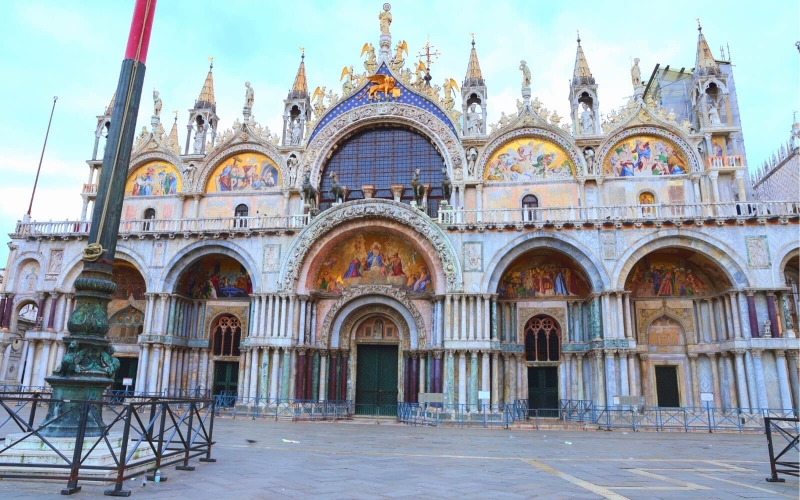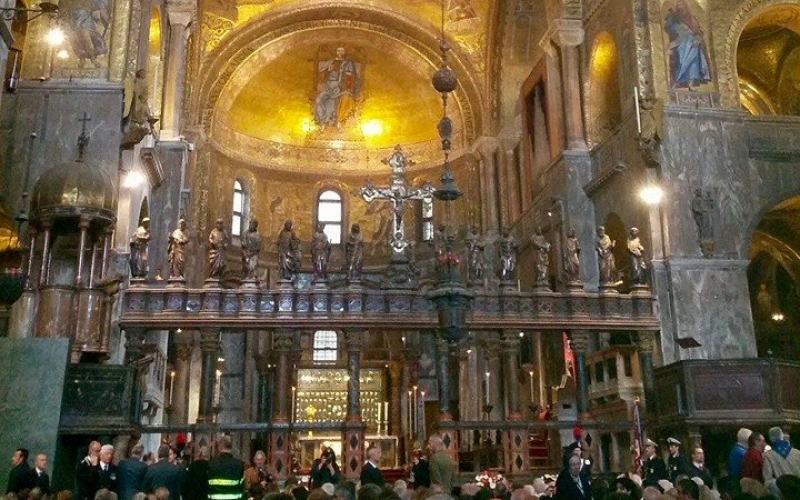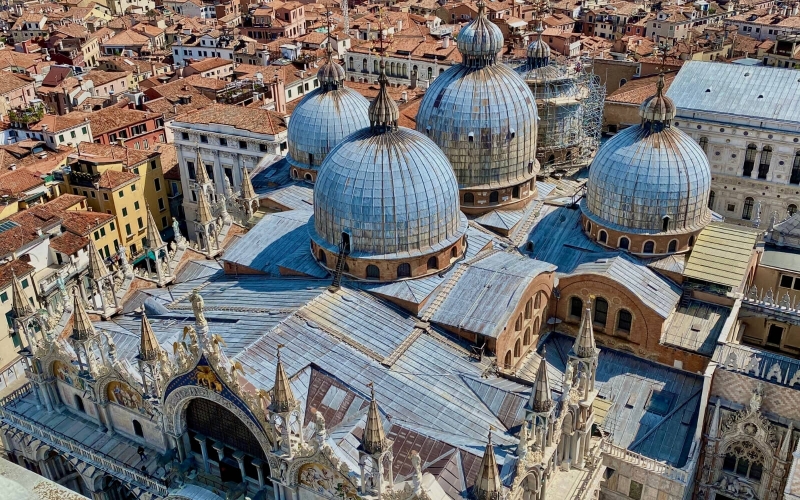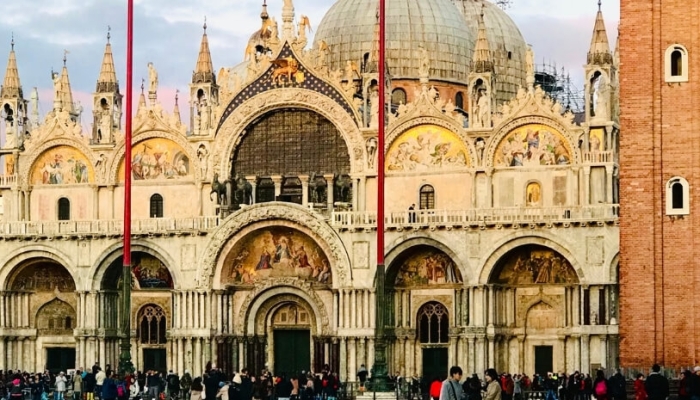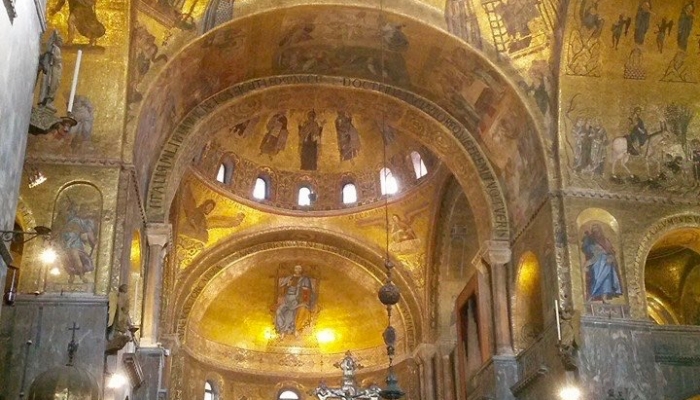
Saint Mark's Basilica in Venice: History, Treasures, and Visitor Info
Church - Basilica di San MarcoThe Saint Mark's Basilica is one of the most celebrated landmarks in Venice, renowned for its magnificent architecture, rich history, and religious significance. Located in the iconic St. Mark's Square, it stands as a masterpiece of Byzantine design, drawing visitors worldwide to admire its mosaics and awe-inspiring interiors.
History of the Building
The origins of Saint Mark’s Basilica date back to the 9th century, deeply intertwined with Venice’s desire for both spiritual and political significance. In 828, Venetian merchants allegedly smuggled the relics of Saint Mark the Evangelist from Alexandria, Egypt, bringing them to Venice. These relics transformed Saint Mark into the patron saint of Venice, and the city’s rulers saw an opportunity to elevate Venice's religious importance by constructing a grand basilica to house these sacred remains.The first basilica built in 828 was a modest structure, soon outgrown by the city's ambition. In 976, it was partially destroyed by fire during a political rebellion, leading to a reconstruction effort that laid the foundation for the basilica we see today. By the 11th century, the basilica was rebuilt in the Byzantine style, inspired by the architecture of Constantinople (modern-day Istanbul), reflecting Venice’s cultural and trade connections with the East.
Over the centuries, Saint Mark’s Basilica became a symbol of Venetian wealth and power, with each Doge (the elected leader of Venice) contributing new artworks, relics, and architectural additions. Its exterior showcases marble, sculptures, and ornate carvings brought from different parts of the world, creating an eclectic yet harmonious façade. The five grand domes of the basilica, added during later renovations, further enhanced its profile as a symbol of Venice’s prestige.
In addition to its religious role, Saint Mark's Basilica also served as the Doge’s private chapel until the fall of the Venetian Republic in 1797, when it became the city’s official cathedral. The basilica was closely linked with Venice's political affairs, hosting numerous ceremonies, including the coronation of Doges, state funerals, and significant diplomatic receptions.
Saint Mark’s Basilica’s iconic golden mosaics, which cover much of its interior, were also added in stages over several centuries. These mosaics depict scenes from the Old and New Testaments and represent a blend of Eastern and Western artistic influences. The use of vibrant colors and shimmering gold creates a luminous atmosphere, symbolizing the glory of heaven. By the Renaissance, Venetian artists also contributed, blending classical Italian influences with the basilica's existing Byzantine style, making it a masterpiece that embodies Venice’s cultural melting pot.
In modern times, Saint Mark's Basilica has faced threats from the rising water levels in Venice. Restoration and preservation efforts have been ongoing to protect the basilica from flooding and environmental damage, ensuring this historic monument remains a timeless symbol of Venice’s unique identity.
Overview of the Treasures Inside
The basilica's interior is a treasure trove of art and history. Visitors can marvel at the golden mosaics covering over 8,000 square meters of the interior, depicting biblical scenes and saints. Other highlights include the Pala d’Oro, an elaborate altarpiece adorned with gold and gemstones, and the Treasury, which houses a collection of relics and artifacts from the Crusades.Pala d’Oro
The Pala d’Oro (Golden Altar) is one of the basilica’s most prized treasures, positioned behind the main altar. Commissioned in the 10th century and completed in stages over centuries, it was crafted by Venetian and Byzantine goldsmiths. The altarpiece is made of gold and adorned with approximately 1,300 pearls, 400 garnets, 300 sapphires, 300 emeralds, and a variety of other precious stones. The Pala d’Oro is notable for its intricate enamel panels that depict scenes from the lives of Christ, the Virgin Mary, and various saints, making it a magnificent example of medieval religious art. This piece not only reflects the craftsmanship of the era but also symbolizes Venice's wealth and devotion.The Treasury
The Treasury of Saint Mark’s Basilica houses a collection of religious relics, valuable artifacts, and exotic objects accumulated over centuries, many brought back from the Crusades. The collection includes reliquaries made of gold and silver, encrusted with jewels, and intricately decorated with images of saints. Visitors will also find rare items such as Byzantine chalices, religious manuscripts, and artifacts made of crystal and ivory. Each item tells a story of Venice’s connections with the East, symbolizing the city’s role as a major trading power in medieval Europe. The Treasury is divided into different rooms, each displaying relics with historical and religious significance.Who might be interested in visiting
Saint Mark's Basilica appeals to a wide range of visitors. History enthusiasts will appreciate its storied past, while art lovers can explore its intricate mosaics and artwork. Religious pilgrims also visit to pay homage to Saint Mark. Families, photographers, and architecture admirers will find much to marvel at in this iconic landmark.Saint Mark's Basilica - The Map
How to Get There
Saint Mark's Basilica is located in St. Mark’s Square, at the heart of Venice.
How to get there:
By Vaporetto: Take line 1 or 2 and get off at the San Zaccaria stop.
By foot: From the Rialto Bridge, it’s a short 10-minute walk.
Opening and Closing Times
Open: Monday to Saturday, 9:30 AM - 5:00 PMSunday and holidays: 2:00 PM - 5:00 PM
Hours may vary on religious holidays.
Ticket Prices or Booking Methods
Entry to Saint Mark's Basilica is €3; certain areas like the Pala d'Oro and Treasury have a small admission fee.Pala d’Oro: €5
Treasury: €3
Museum - Loggia dei Cavalli: €7
Advance booking is recommended, especially in peak seasons.
Museum - Loggia dei Cavalli: €7
Advance booking is recommended, especially in peak seasons.
